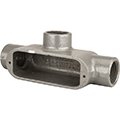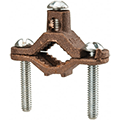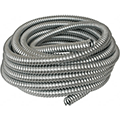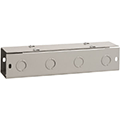Conduits, Ducts & Routing
Conduits, Ducts, and Routing
Routing electrical power in an industrial setting can be a mind-boggling experience. Fortunately, at Penn Tool Co., we offer an expansive selection of diverse conduits for lighting.
Electrical Conduits and Equipment for Lighting
Selecting the best components to get power where it is needed safely can be a simple decision-making process. First, determine where power is required. Then, find the approved routing components to do the job.
Wire Conduits
The number of conduit types is astonishing; there’s a type of wire conduit to accommodate any power distribution requirement. Steel Conduit is the most common wire routing technology, with several grades for indoor, outdoor, waterproof, and dustproof applications.
Selecting the correct conduit type, fittings, and boxes can accomplish nearly any routing project. Flexible conduit is a little more expensive than its rigid counterpart, but the time savings makes it a viable alternative. Light-duty flex conduit is made of aluminum. Medium or heavy-duty flex is made of steel. Both styles can be made waterproof with a rugged rubber exterior coating.
Light-duty applications can make use of rigid or flexible PVC conduit. PVC conduit is produced in exterior and interior formulations. The exterior grade is UV and temperature resistant.
Conduit Bodies and Accessories
When laying out an electrical system, connections, junctions, and corners are part of the design. Conduit bodies provide a space to connect circuits or change directions. Removable covers make for easy access.
The handiest bodies are designed to provide a change of direction or space to split a circuit. Bodies for left turns, right turns, back turns, T’s, and four-way connections allow easy direction changes.
As with conduit, conduit bodies are designed with specific applications in mind. Light-duty, heavy-duty, water-tight and hazardous locations all demand particular characteristics. Every style of conduit body has a matching gasket, cover, and connective fitting. It is essential to know the hazard level of the workplace before beginning to install an electrical system.
Wall Wire Ducts and Accessories
Use a wall wire duct when several junctions or access points are required in close proximity. A wire duct combines the functions of an electrical box and a conduit body. The duct provides space for several junctions and access points for branch circuits.
Branches then exit the duct via other knockouts and connect to nearby equipment. In most cases, the main body of a wire duct is attached to the wall with screws. Application-specific end-caps are required.
When circuit installation is complete, a screw-on cover protects the contents. As with conduit, ducts are constructed with various materials for different applications.
Cable and hose carriers
A cable & hose carrier will do the job in cases where motion must be accommodated. These flexible conduits protect electrical cables, signal wires, and flexible pneumatic or hydraulic hoses.
Carriers are built like a chain and protect circuits that must move in a linear, back-and-forth motion. Light-duty applications like robotic assembly devices may use carriers constructed of plastic.
Heavy-duty machines, like overhead cranes, will require steel carriers. Stainless steel carriers can withstand hazardous or corrosive environments.
Find the Best Cable Conduits for Lighting at Penn Tool Co.
To design the best electrical distribution system for your workshop, reach out to our team today.









